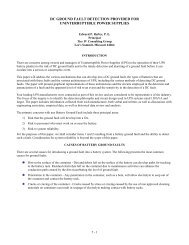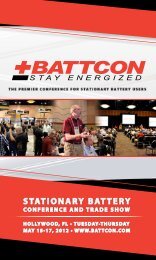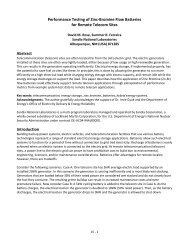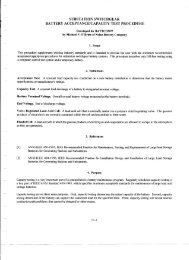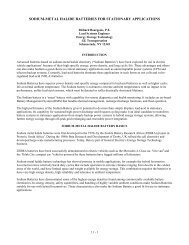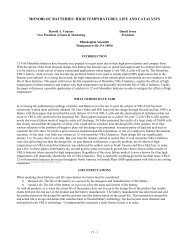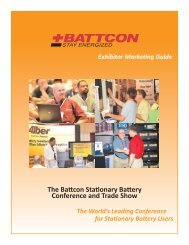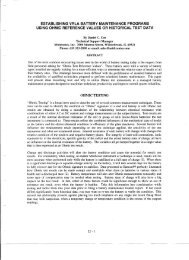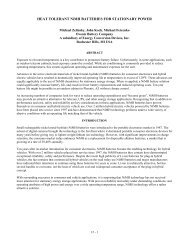FLOODED (VLA ), SEALED (VRLA), GEL, AGM TYPE, FLAT PLATE ...
FLOODED (VLA ), SEALED (VRLA), GEL, AGM TYPE, FLAT PLATE ...
FLOODED (VLA ), SEALED (VRLA), GEL, AGM TYPE, FLAT PLATE ...
Create successful ePaper yourself
Turn your PDF publications into a flip-book with our unique Google optimized e-Paper software.
Operational life<br />
Costs<br />
Stable capacity<br />
Short-time capacity<br />
Thermal-run-away<br />
Initial inner resistance<br />
Cycle life<br />
Safe against deep discharges<br />
Tubular plates possible<br />
<strong>AGM</strong><br />
<strong>GEL</strong><br />
Figure 9. Characteristics of <strong>VRLA</strong> <strong>AGM</strong> versus <strong>VRLA</strong> <strong>GEL</strong><br />
CONCLUSION<br />
We try to give here proposals to application engineers as to which battery type fits best to customer requirements, based on<br />
the information presented in this paper.<br />
For electrical systems of a very high safety level, like utilities, bank data centers, military or security applications, the <strong>VLA</strong><br />
types have advantages versus the <strong>VRLA</strong> types. Visual inspection and gravity readings give more safety. For bridging times or<br />
peak current requirements of 60min or shorter, the <strong>VLA</strong> flat plate batteries provide a better power-per $ ratio. For bridging<br />
times of more than 60 min, the <strong>VLA</strong> tubular is the preferred choice.<br />
In systems where the advantages of <strong>VRLA</strong> systems count, we see the <strong>AGM</strong> type in front for UPS applications, as far as<br />
bridging times of 60 min and lower are required and where life time expectations are limited, because the technical<br />
innovation requires a new power supply in the next 5 to 10 years anyway.<br />
If the electrical system has an expected usage of 10 to 20 years, <strong>VRLA</strong> <strong>GEL</strong> batteries should be preferred: <strong>VRLA</strong> <strong>GEL</strong><br />
tubular plate batteries for discharge times of 60 min and longer and <strong>VRLA</strong> <strong>GEL</strong> flat plate batteries for 30min and shorter.<br />
For solar applications, maintenance-free batteries with very high cycle life are required. Here, the <strong>VRLA</strong> tubular <strong>GEL</strong> is the<br />
best choice.<br />
REFERENCES<br />
1. Berndt, D, Bräutigam, R, and Teutsch, U, “Temperature Compensation of Float Voltage – The Special Situation of<br />
<strong>VRLA</strong> Batteries,” INTELEC 1995, Session 1-1<br />
2. Berndt, D, “Maintenance-Free Batteries,” A Handbook of Battery Technology, John Wiley & Sons Inc.<br />
3. Berndt, D, Meißner, E, Rusch, W, “Aging effects in valve-regulated lead-acid batteries,” 15. INTELEC 1993, Paris,<br />
Volume 2, 139 – 145<br />
6 - 9



